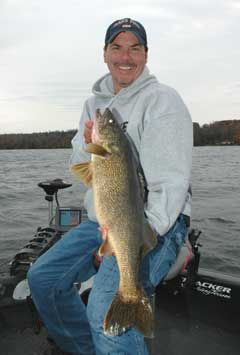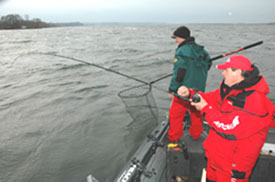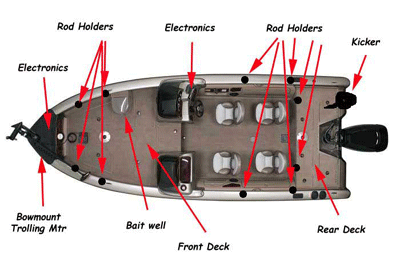 In the quest for finding the ultimate in walleye fishing success, it’s often the most basic aspects of angling that get over looked.
In the quest for finding the ultimate in walleye fishing success, it’s often the most basic aspects of angling that get over looked.
You can have every new lure on the market, all the right rods, reels and line, but if you can’t be efficient on the water, you’re still going to struggle. Being efficient on the water has much to do with how you utilize your “fishing stations”: those areas in your boat where the bulk of your fishing day is spent. A well organized fishing station will ensure that everything you need will be with “right at your fingertips” at all times. It’s all about rigging your boat to fit the way you fish.
A walleye boat has three “fishing stations”: The Searching Station, the Bow Fishing Station and the Stern Fishing Station. Each should be rigged and configured to fit you and how you fish. While I outline how I go about this process, keep in mind that not all my ideas will work for every angler. The idea is to put some thought into the set-up of “your” fishing stations so that once you’re on the water you can more efficiently do what you’re out there to do … catch fish.
The Searching Station:
The Searching Station is the area around your console. It’s more than just a spot from which to drive the boat. Walleye anglers spend much time searching… whether that’s for structure, fish or that magic spot on the spot. You’ll want this to be an efficient and well organized area of the boat. This is where you’ll want your best electronics and you’ll want them mounted in such a way so that they’ll be easy to read as you run down the lake, without having to turn your head or divert your eyes too far from looking where you’re going.
Depending on how the console of your boat is configured, the placement of your electronics may be a relatively easy task, or it may offer some challenges. For instance, on my last couple of boats, I ran a top-of-the-line Lowrance LCX-111 C HD as my locator as well as a GlobalMap 7600 C HD GPS unit at my console position. Now these are large units, with ten inch displays.
That makes them tough to fit on a boat’s console, so I had to position them to the side of the console and mount them using super large RAM Mounts (model RAM-D-111-U). These types of mounts allowed positioning my units at eye level and at the right angles so I could easily glance at the screens while running the boat. With smaller screened units, it becomes even more critical to proper positioning so that you can see them easily and efficiently.
Other considerations for the Searching Station would include where you mount your marine band radio and for those that use them, your underwater camera system. Spend time sitting in your boat and thinking about how you use these items. Then make sure they are positioned to fit your needs.

The Bow Fishing Station:
Many anglers consider the front deck of their boat as nothing more than a casting platform. That’s fine for muskie and bass fishermen, but when it comes to walleye fishing, there are many techniques besides casting that are performed from the Bow Fishing Station. Jigging, rigging, bottom bouncer trolling as well as casting are all tactics done from the front of the boat. Boat manufacturers have learned this and many walleye boats now come with larger front decks than in years past. Many also feature front live wells and built-in bait wells within easy reach of the bow angler.
One of the first decisions most walleye anglers make in reference to their Bow Fishing Station is the choice of seat. While many opt for the taller pedestal “bicycle” or “stand-up” style, I prefer the standard full boat seat. Those that go with the stand-up style seat say they find it to be a more comfortable position for working the trolling motor, and when vertical jigging it gives them a better hook-setting position. I can agree with that, but over the years, I have found that the seated position saves a lot of wear and tear on both my legs and my back. After all, I can always stand up when jigging, but when I’m trolling bouncers or rigging, I really like the back support and comfort of being in a seated position. It’s all personal preference.
Similar to the Searching Station, the choice and placement of your electronics is important up front too. I see a lot of guys rig their front locator and GPS units down on the floor of the boat. I feel a much better option is to mount these units up on the bow deck next to your bowmount trolling motor. Make this unit (or units) as easy to see as possible when you’re fishing. You don’t want to skimp on quality here either.
It’s OK to go with a smaller screened unit than you have at the Searching Station position, and it will often save a little room if you go with a sonar/GPS combo unit on the bow, but make sure this is a good quality unit with power and resolution to give you a good view of what you’re fishing. If you’re not sure about using a GPS on the bow, I encourage you to do so. Fishing complex structures precisely is made much more effective by utilizing both a good sonar and a GPS unit.
Rod holder placement is another big consideration when you’re setting up your Bow Fishing Station. I suggest mounting four rod holders in the bow, and you’ll want these placed so that they’re right at your finger tips. I locate mine by actually sitting in the seat and position a holder on either side directly below each hand. Then I place another one about twelve to eighteen inches ahead of each of those. That gives me four rod positions, all with in easy reach. My rod holders of choice are RAM-117 rod holders. I like this style rod holder because of its complete adjustability. I can set it at virtually any angle, or simply fold it down and out of the way when not in use.
Of course the electric bowmount trolling motor is the big tool of your Bow Fishing Station. A couple of common mistakes many anglers make when choosing a bowmount are to go with too short a shaft on their motor and too little power. Walleye fishing often finds us dealing with strong currents or big winds and rough water. The long shaft will help keep the business end of the motor where it does you the most good (in the water), and it’s a basic fact of fishing … more power is always better.

The Stern Fishing Station:
The back of the boat is where a lot of walleye anglers spend much of their time, especially when trolling or as a rear casting and jigging position. For that reason, you want to make sure this area of the boat has plenty of room for you and your gear while providing ample space to move around. Many of today’s walleye boats are designed with a raised rear deck section that provides an ideal position for casting and jigging presentations. In my Tracker TUNDRA 21, I use the raised rear deck while trolling too, as a sort of work table when trolling. I can lay out my baits, boards and release tools, keeping everything handy and where I can easily get at them.
For trolling, a kicker motor mounted next to the boat’s main engine is a must. While some use a steering bar to connect this motor to the main engine so they can steer it from the console, I encourage you to run your kicker using a tiller handle. This will quite simply give you much better maneuverability and steering radius. If your boat has a rear deck area like mine, you’ll also want to equip your kicker with an extension handle so that it’s easier to steer.
Because this area of the boat is used so much for trolling, rod holder placement again is a major concern. I mount two rod holders along either gunnel with the forward most holder positioned just behind the driver seat. Make sure when you mount these that you leave room so that the rod handle is not hitting the seat when it’s in the holder. The next rod holder I position so that its right at my finger tips when I’m steering the kicker motor, with another holder in the same position on the opposite side of the boat. I also mount two more rod holders on the front of my rear deck, one near each gunnel. These are used for flat lines run out behind the boat, or for holding rods as I’m rotating board positions or clearing lines for fighting fish in. That puts six rod holders in my Stern Fishing Station, all with in easy reach. When it comes to electronics for the Stern Fishing Station, some fishermen like to mount separate units in the back where they’re easily viewable when trolling. Because the units I use on my console have such large screens and are easy to see from the back of the boat, I just use them.
I suppose you could think of all this attention to Fishing Station detail as Feng Shui boat rigging, bordering on compulsive-obsessive behavior, or even being anal-retentive. What ever the case, paying attention to the details of rigging your boat to fit your fishing is a key factor to overall angling success. It’s as important as sharpening your hooks or using fresh fishing line. But hey, if you aren’t that concerned about catching more fish, that’s OK … leaves more for me!










